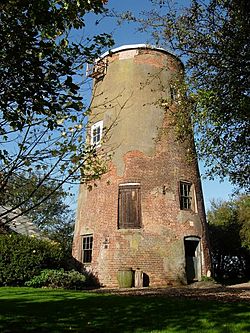Stansfield Windmill facts for kids
Quick facts for kids Stansfield Mill |
|
|---|---|

The mill in 2006
|
|
| Origin | |
| Mill location | TL 785 528 |
| Coordinates | 52°08′40″N 0°36′35″E / 52.14444°N 0.60972°E |
| Operator(s) | Private |
| Year built | 1840 |
| Information | |
| Purpose | Corn mill |
| Type | Tower mill |
| Storeys | Five storeys |
| No. of sails | Four Sails |
| Type of sails | Patent sails |
| Winding | Fantail |
| No. of pairs of millstones | Two pairs |
Stansfield Mill is a special old building in Stansfield, Suffolk, England. It is a type of tower mill that used wind power to grind grain. Today, it is a Grade II listed building, which means it is protected because of its history and importance. However, the mill is currently empty and not working, which is called being derelict.
Contents
The Story of Stansfield Mill
When Was Stansfield Mill Built?
Stansfield Mill was built a long time ago, in 1840. It was built to replace an even older type of windmill called a post mill. A post mill is a windmill where the whole body of the mill turns on a central post.
Who Built This Windmill?
The person who built Stansfield Mill was likely William Bear. He was a skilled builder of mills, known as a millwright, from Sudbury. Millwrights were like engineers and carpenters all in one, specializing in building and fixing mills.
Why Did the Mill Stop Working?
We don't know exactly when Stansfield Mill stopped grinding corn. But we do know that in 1922, the top part of the mill, called the cap, was taken off. After that, the mill was left empty and slowly fell into disrepair.
How Stansfield Mill Was Designed
What Does a Tower Mill Look Like?
Stansfield Mill is a tower mill, which means it has a tall, round stone or brick tower. This mill has five floors inside. It used to have a special dome-shaped cap on top.
How Did the Mill Catch the Wind?
The cap of the mill could turn to face the wind. It moved thanks to a special part called a fantail. A fantail is a small windmill at the back of the cap that automatically turns the main sails into the wind.
What Were the Sails Like?
The mill had four large Patent sails. These were advanced sails for their time. They could be adjusted from inside the mill, which made it easier to control how much wind they caught.
What Machinery Was Inside?
Inside the mill, most of the machinery was made of wood. This included a large gear called a clasp arm great spur wheel. This wheel helped to transfer power from the sails to the grinding stones. The mill had two pairs of millstones. These heavy stones would spin to grind grain into flour.

